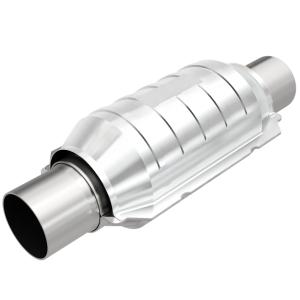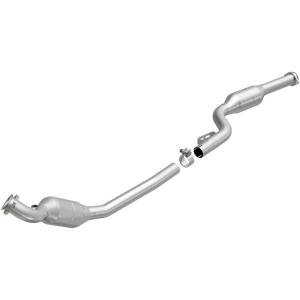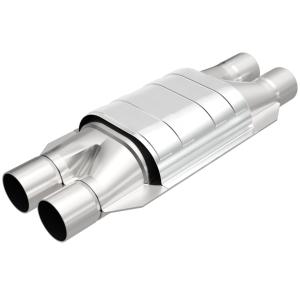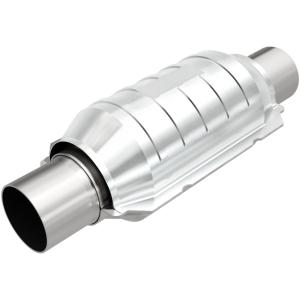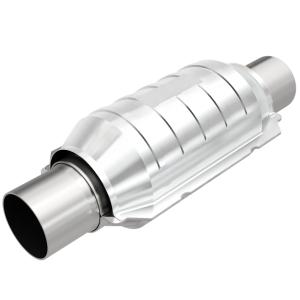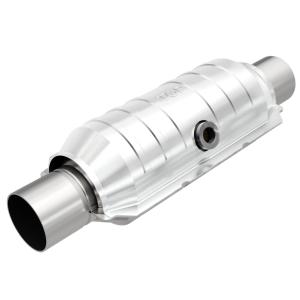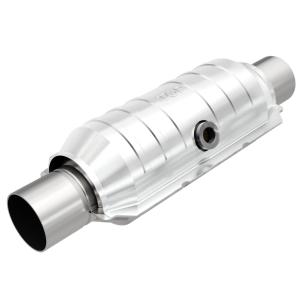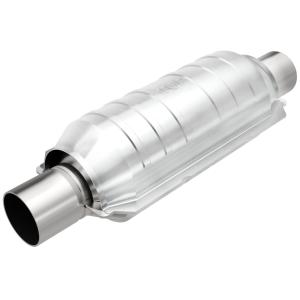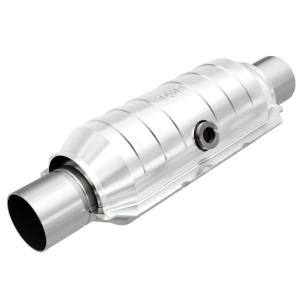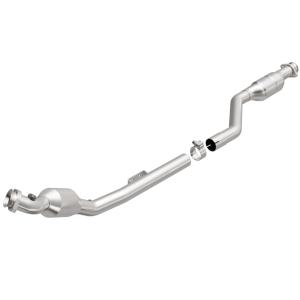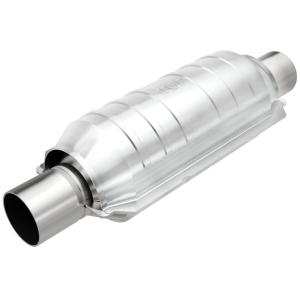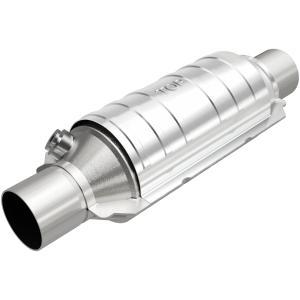Hello, Sign In!
Mercedes E-Class Catalytic Converters
At Andy's Auto Sport, we have a huge variety of Mercedes E-Class catalytic converters to ensure that you have every catalytic converter option available to you. We go out of our way to carry every major line of Mercedes E-Class catalytic converters, so that whether you are looking for replacement Mercedes E-Class catalytic converter or a performance high flow cat or anything in between, we've got it for you. Andy's Auto Sport is the ultimate shopping destination for your Mercedes E-Class catalytic converter needs!
Select Your Vehicle
Shop Mercedes E-Class Catalytic Converters by Year
Shop Mercedes E-Class Catalytic Converters by Brand
1 - 12 of 44
Sort by:

Fits: 2004 Mercedes-Benz E320, 2002 Mercedes-Benz E320, 2003 Mercedes-Benz CLK320, 2003 Mercedes-Benz E320, 2005 Mercedes-Benz C240, 2004 Mercedes-Benz CLK3...
PART# 451204

Fits: 00-02 Mercedes E-Class E430(V 8 4.3 LGAS), 98-03 Mercedes E320 (V 6 3.2 LGAS)
PART# 24396

Fits: 1994 Mercedes-Benz S320; 3.2, 6L, 1985 Porsche 928;5, 8V, 1995 Mercedes-Benz E320; 3.2, 6L, 1994 Mercedes-Benz E320; 3.2, 6L, 1986 Porsche 928;5, 8V, ...
PART# 94008

Fits: 2004 Mercedes-Benz E320, 2002 Mercedes-Benz E320, 2003 Mercedes-Benz CLK320, 2003 Mercedes-Benz E320, 2005 Mercedes-Benz C240, 2004 Saturn L300 2, 200...
PART# 454204

Fits: 2003 Mercedes-Benz SL500, 2001 Mercedes-Benz E430, 2003 Mercedes-Benz CL500, 2004 Saturn L300 2, 2002 Mercedes-Benz S430, 2005 Saturn L300, 2001 Merce...
PART# 451205

Fits: 2001 Mercedes-Benz E320
PART# 454355

Fits: 2000 Mercedes-Benz E320, 2000 Mercedes-Benz CLK320
PART# 444355

Fits: 2004 Mercedes-Benz E320, 2001 Mercedes-Benz E430, 2002 Mercedes-Benz E320, 2003 Mercedes-Benz E320, 2002 Mercedes-Benz S430, 2003 Mercedes-Benz S430
PART# 454305

Fits: 2004 Mercedes-Benz E320, 2002 Mercedes-Benz E320, 2003 Mercedes-Benz E320, 2001 Mercedes-Benz E320
PART# 451255

Fits: 01-02 Mercedes E-Class E430(V 8 4.3 LGAS)
PART# 454032

Fits: 2000 Mercedes-Benz S430; 4.3, 8V, 2000 Oldsmobile Alero; 3.4, 6V, 2004 Pontiac Grand Am; 3.4, 6V, 2000 Pontiac Grand Prix; 3.1, 6V, 2002 Pontiac Monta...
PART# 51305

Fits: 1998 Pontiac Grand Am; 3.1, 6V, 2000 Mercedes-Benz C280; 2.8, 6V, 2004 Pontiac Grand Am; 3.4, 6V, 1997 Pontiac Grand Am; 3.1, 6V, 2002 Pontiac Montana...
PART# 99305HM
When you click on links to various merchants on this site and make a purchase, this can result in this site earning a commission. Affiliate programs and affiliations include, but are not limited to, the eBay Partner Network.
Not able to find what you are looking for?


644200 AP Exhaust Catalytic Converter Driver Left Side for MB Mercedes E Class

Magnaflow 51665 Catalytic Converters Driver Left Side for MB Mercedes E Class

40835 Eastern Catalytic Converter Driver Left Side for MB Mercedes E Class Hand

644221 AP Exhaust Catalytic Converter Driver Left Side for MB Mercedes E Class

18547 Davico Catalytic Converter Passenger Right Side for MB Mercedes E Class C

18546 Davico Catalytic Converter LH Side For MB Mercedes E Class 46-state legal
WHY TO BUY?
The good news is that, although replacement Mercedes E-Class catalytic converters can be costly from your local dealership, aftermarket units (many times made by the same original equipment manufacturers) are substantially less expensive and can be purchased as direct-fit bolt-on units (assuming that the original converter was also bolted on) or weld-on units. Replacing your Mercedes E-Class catalytic converter can restore power that has been lost due to a faulty original converter and will make your vehicle run better overall. In addition, a bad Mercedes E-Class catalytic converter means that your exhaust is releasing harmful toxins into the atmosphere and environment, so getting a new one means you’re doing your part to keep the earth and its atmosphere clean.
DID YOU KNOW?
Modern catalytic converters are much less restrictive than in days past, so much so that the antiquated (and illegal) method of "gutting" the converters of their internal structures has been deemed almost pointless on newer cars, as the performance gains are minimal, if any. Aftermarket high-flow Mercedes E-Class catalytic converters are therefore a much better (and more responsible) choice for those seeking to upgrade their exhaust systems or replace a faulty converter.
So how do you know if your Mercedes E-Class catalytic converter is on its way out? If your Mercedes E-Class engine seems to be losing power or your temperature gauge reads a little high, one possible culprit could be that a rich condition is feeding excessive unburned fuel into the catalytic converter, which can overheat it as well as damage it. It is common to see your Mercedes E-Class catalytic converter glowing orange/red when this condition is present. Another common sign of catalytic converter failure is the infamous "rotten egg" smell. Other common symptoms include: a lack of power, rough engine idle, or stalling. If you are replacing your Mercedes E-Class catalytic converter due to any of the above circumstances, it is a good idea to also replace your oxygen sensor, since it plays a vital role in the air/fuel mixture ratio and may have also been damaged due to the same adverse conditions. Finally, physical damage can sometimes occur if a large rock or other object hits Mercedes E-Class catalytic converter, resulting in a damaged ceramic core. This can often be heard, as smaller ceramic pieces will bounce around inside the converter housing. As you can imagine, this is often accompanied by a loss of power due to exhaust blockage.
So how do you know if your Mercedes E-Class catalytic converter is on its way out? If your Mercedes E-Class engine seems to be losing power or your temperature gauge reads a little high, one possible culprit could be that a rich condition is feeding excessive unburned fuel into the catalytic converter, which can overheat it as well as damage it. It is common to see your Mercedes E-Class catalytic converter glowing orange/red when this condition is present. Another common sign of catalytic converter failure is the infamous "rotten egg" smell. Other common symptoms include: a lack of power, rough engine idle, or stalling. If you are replacing your Mercedes E-Class catalytic converter due to any of the above circumstances, it is a good idea to also replace your oxygen sensor, since it plays a vital role in the air/fuel mixture ratio and may have also been damaged due to the same adverse conditions. Finally, physical damage can sometimes occur if a large rock or other object hits Mercedes E-Class catalytic converter, resulting in a damaged ceramic core. This can often be heard, as smaller ceramic pieces will bounce around inside the converter housing. As you can imagine, this is often accompanied by a loss of power due to exhaust blockage.
FAQs
Q: What is a hi-flow catalytic converter? Why buy one?
A: All stock catalytic converters are restrictive when it comes to exhaust flow, and they essentially place a choke hold on performance. The hi-flow catalytic converters on the market today have a higher flow capacity than factory units. Still able to pass emissions and gain horsepower, how can you go wrong with a hi-flow catalytic converter?
Q: How do you install a hi-flow catalytic converter?
A: There are two kinds of catalytic converters. The first are direct fit converters (no welding required) which have all necessary flanges and oxygen sensors just like the original equipment catalytic converters. There are also universal fit catalytic converters that are designed to be welded or clamped in place. Universal fit converters have the same flow characteristics as direct fit models with the same inlet and outlet diameter.
A: All stock catalytic converters are restrictive when it comes to exhaust flow, and they essentially place a choke hold on performance. The hi-flow catalytic converters on the market today have a higher flow capacity than factory units. Still able to pass emissions and gain horsepower, how can you go wrong with a hi-flow catalytic converter?
Q: How do you install a hi-flow catalytic converter?
A: There are two kinds of catalytic converters. The first are direct fit converters (no welding required) which have all necessary flanges and oxygen sensors just like the original equipment catalytic converters. There are also universal fit catalytic converters that are designed to be welded or clamped in place. Universal fit converters have the same flow characteristics as direct fit models with the same inlet and outlet diameter.
Filter Your Results
Category 

-
Catalytic Converters(44)
Brand 

-
 MagnaFlow(44)
MagnaFlow(44)
Mercedes E-Class Catalytic Converters
At Andy's Auto Sport, we have a huge variety of Mercedes E-Class catalytic converters to ensure that you have every catalytic converter option available to you. We go out of our way to carry every major line of Mercedes E-Class catalytic converters, so that whether you are looking for replacement Mercedes E-Class catalytic converter or a performance high flow cat or anything in between, we've got it for you. Andy's Auto Sport is the ultimate shopping destination for your Mercedes E-Class catalytic converter needs!
Choose Your Vehicle:
Shop Mercedes E-Class Catalytic Converters by Year
Shop Mercedes E-Class Catalytic Converters by Brand
1 - 12 of 44
Sort by:

Fits: 2004 Mercedes-Benz E320, 2002 Mercedes-Benz E320, 2003 Mercedes-Benz CLK320, 2003 Mercedes-Benz E320, 2005 Mercedes-Benz C240, 2004 Mercedes-Benz CLK3...
PART# 451204

Fits: 00-02 Mercedes E-Class E430(V 8 4.3 LGAS), 98-03 Mercedes E320 (V 6 3.2 LGAS)
PART# 24396

Fits: 1994 Mercedes-Benz S320; 3.2, 6L, 1985 Porsche 928;5, 8V, 1995 Mercedes-Benz E320; 3.2, 6L, 1994 Mercedes-Benz E320; 3.2, 6L, 1986 Porsche 928;5, 8V, ...
PART# 94008

Fits: 2004 Mercedes-Benz E320, 2002 Mercedes-Benz E320, 2003 Mercedes-Benz CLK320, 2003 Mercedes-Benz E320, 2005 Mercedes-Benz C240, 2004 Saturn L300 2, 200...
PART# 454204

Fits: 2003 Mercedes-Benz SL500, 2001 Mercedes-Benz E430, 2003 Mercedes-Benz CL500, 2004 Saturn L300 2, 2002 Mercedes-Benz S430, 2005 Saturn L300, 2001 Merce...
PART# 451205

Fits: 2001 Mercedes-Benz E320
PART# 454355

Fits: 2000 Mercedes-Benz E320, 2000 Mercedes-Benz CLK320
PART# 444355

Fits: 2004 Mercedes-Benz E320, 2001 Mercedes-Benz E430, 2002 Mercedes-Benz E320, 2003 Mercedes-Benz E320, 2002 Mercedes-Benz S430, 2003 Mercedes-Benz S430
PART# 454305

Fits: 2004 Mercedes-Benz E320, 2002 Mercedes-Benz E320, 2003 Mercedes-Benz E320, 2001 Mercedes-Benz E320
PART# 451255

Fits: 01-02 Mercedes E-Class E430(V 8 4.3 LGAS)
PART# 454032

Fits: 2000 Mercedes-Benz S430; 4.3, 8V, 2000 Oldsmobile Alero; 3.4, 6V, 2004 Pontiac Grand Am; 3.4, 6V, 2000 Pontiac Grand Prix; 3.1, 6V, 2002 Pontiac Monta...
PART# 51305

Fits: 1998 Pontiac Grand Am; 3.1, 6V, 2000 Mercedes-Benz C280; 2.8, 6V, 2004 Pontiac Grand Am; 3.4, 6V, 1997 Pontiac Grand Am; 3.1, 6V, 2002 Pontiac Montana...
PART# 99305HM
When you click on links to various merchants on this site and make a purchase, this can result in this site earning a commission. Affiliate programs and affiliations include, but are not limited to, the eBay Partner Network.
Not able to find what you are looking for?


644200 AP Exhaust Catalytic Converter Driver Left Side for MB Mercedes E Class

Magnaflow 51665 Catalytic Converters Driver Left Side for MB Mercedes E Class

40835 Eastern Catalytic Converter Driver Left Side for MB Mercedes E Class Hand

644221 AP Exhaust Catalytic Converter Driver Left Side for MB Mercedes E Class

18547 Davico Catalytic Converter Passenger Right Side for MB Mercedes E Class C

18546 Davico Catalytic Converter LH Side For MB Mercedes E Class 46-state legal
WHY TO BUY?
The good news is that, although replacement Mercedes E-Class catalytic converters can be costly from your local dealership, aftermarket units (many times made by the same original equipment manufacturers) are substantially less expensive and can be purchased as direct-fit bolt-on units (assuming that the original converter was also bolted on) or weld-on units. Replacing your Mercedes E-Class catalytic converter can restore power that has been lost due to a faulty original converter and will make your vehicle run better overall. In addition, a bad Mercedes E-Class catalytic converter means that your exhaust is releasing harmful toxins into the atmosphere and environment, so getting a new one means you’re doing your part to keep the earth and its atmosphere clean.
DID YOU KNOW?
Modern catalytic converters are much less restrictive than in days past, so much so that the antiquated (and illegal) method of "gutting" the converters of their internal structures has been deemed almost pointless on newer cars, as the performance gains are minimal, if any. Aftermarket high-flow Mercedes E-Class catalytic converters are therefore a much better (and more responsible) choice for those seeking to upgrade their exhaust systems or replace a faulty converter.
So how do you know if your Mercedes E-Class catalytic converter is on its way out? If your Mercedes E-Class engine seems to be losing power or your temperature gauge reads a little high, one possible culprit could be that a rich condition is feeding excessive unburned fuel into the catalytic converter, which can overheat it as well as damage it. It is common to see your Mercedes E-Class catalytic converter glowing orange/red when this condition is present. Another common sign of catalytic converter failure is the infamous "rotten egg" smell. Other common symptoms include: a lack of power, rough engine idle, or stalling. If you are replacing your Mercedes E-Class catalytic converter due to any of the above circumstances, it is a good idea to also replace your oxygen sensor, since it plays a vital role in the air/fuel mixture ratio and may have also been damaged due to the same adverse conditions. Finally, physical damage can sometimes occur if a large rock or other object hits Mercedes E-Class catalytic converter, resulting in a damaged ceramic core. This can often be heard, as smaller ceramic pieces will bounce around inside the converter housing. As you can imagine, this is often accompanied by a loss of power due to exhaust blockage.
So how do you know if your Mercedes E-Class catalytic converter is on its way out? If your Mercedes E-Class engine seems to be losing power or your temperature gauge reads a little high, one possible culprit could be that a rich condition is feeding excessive unburned fuel into the catalytic converter, which can overheat it as well as damage it. It is common to see your Mercedes E-Class catalytic converter glowing orange/red when this condition is present. Another common sign of catalytic converter failure is the infamous "rotten egg" smell. Other common symptoms include: a lack of power, rough engine idle, or stalling. If you are replacing your Mercedes E-Class catalytic converter due to any of the above circumstances, it is a good idea to also replace your oxygen sensor, since it plays a vital role in the air/fuel mixture ratio and may have also been damaged due to the same adverse conditions. Finally, physical damage can sometimes occur if a large rock or other object hits Mercedes E-Class catalytic converter, resulting in a damaged ceramic core. This can often be heard, as smaller ceramic pieces will bounce around inside the converter housing. As you can imagine, this is often accompanied by a loss of power due to exhaust blockage.
FAQs
Q: What is a hi-flow catalytic converter? Why buy one?
A: All stock catalytic converters are restrictive when it comes to exhaust flow, and they essentially place a choke hold on performance. The hi-flow catalytic converters on the market today have a higher flow capacity than factory units. Still able to pass emissions and gain horsepower, how can you go wrong with a hi-flow catalytic converter?
Q: How do you install a hi-flow catalytic converter?
A: There are two kinds of catalytic converters. The first are direct fit converters (no welding required) which have all necessary flanges and oxygen sensors just like the original equipment catalytic converters. There are also universal fit catalytic converters that are designed to be welded or clamped in place. Universal fit converters have the same flow characteristics as direct fit models with the same inlet and outlet diameter.
A: All stock catalytic converters are restrictive when it comes to exhaust flow, and they essentially place a choke hold on performance. The hi-flow catalytic converters on the market today have a higher flow capacity than factory units. Still able to pass emissions and gain horsepower, how can you go wrong with a hi-flow catalytic converter?
Q: How do you install a hi-flow catalytic converter?
A: There are two kinds of catalytic converters. The first are direct fit converters (no welding required) which have all necessary flanges and oxygen sensors just like the original equipment catalytic converters. There are also universal fit catalytic converters that are designed to be welded or clamped in place. Universal fit converters have the same flow characteristics as direct fit models with the same inlet and outlet diameter.
VIDEOS RELATED TO MERCEDES E-CLASS CATALYTIC CONVERTERS
VIDEOS RELATED TO MERCEDES E-CLASS CATALYTIC CONVERTERS
-
Video Description:Catalytic Converters on Andy's Auto Sport TV!
This is an Andy's Auto Sport TV episode where we break down the basics of catalytic converters. We explain the difference between a direct-fit bolt-on catalytic converter and a universal weld-on catalytic converter. We also go over the benefits of getting a new cat, and we even do an installation to show what's involved.


